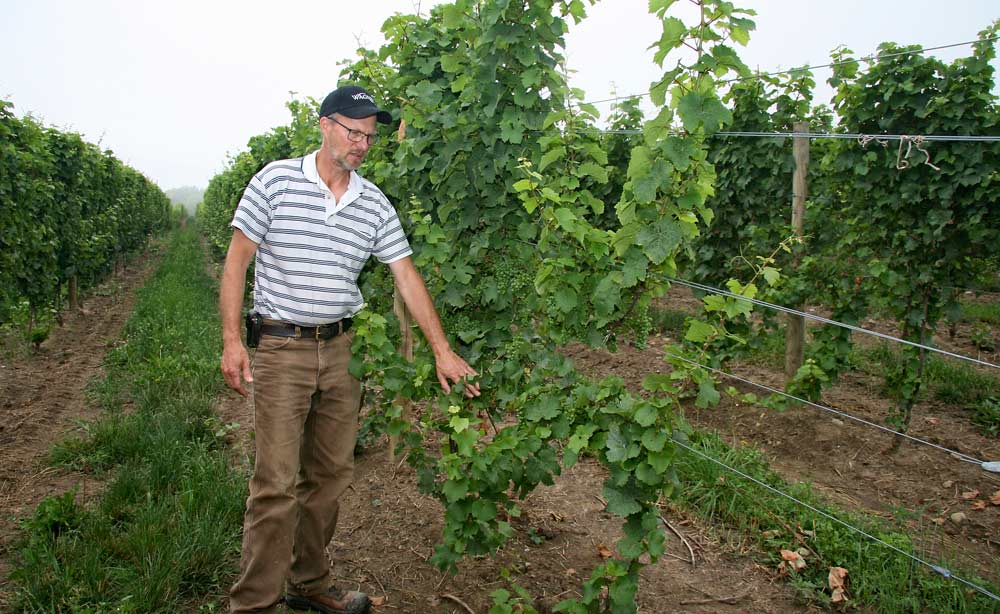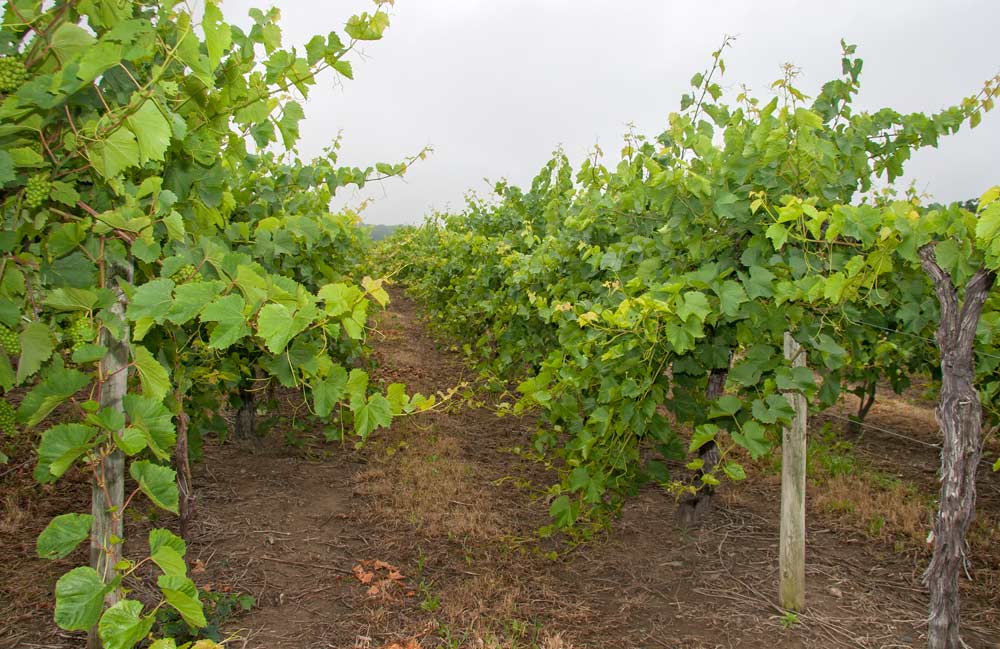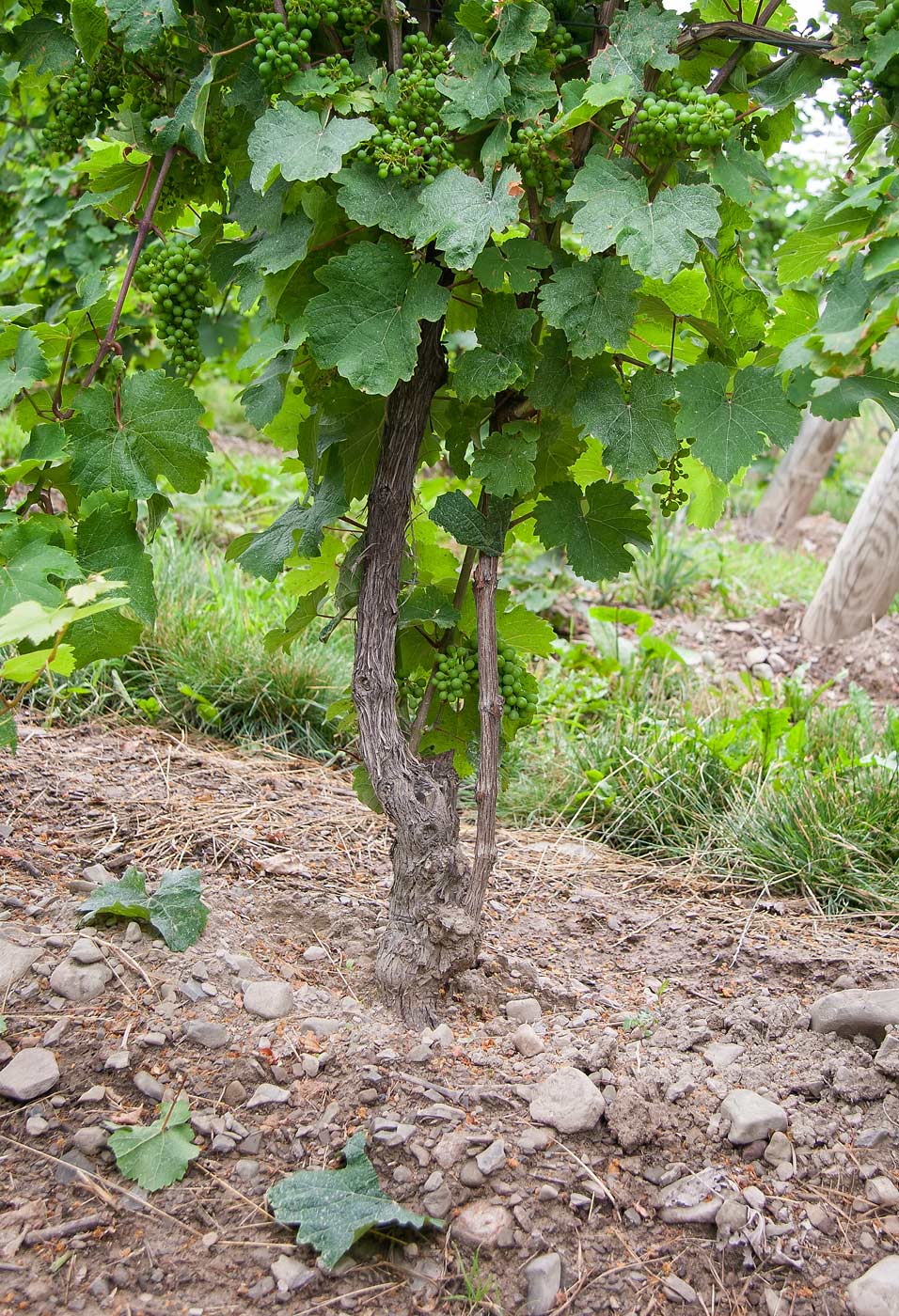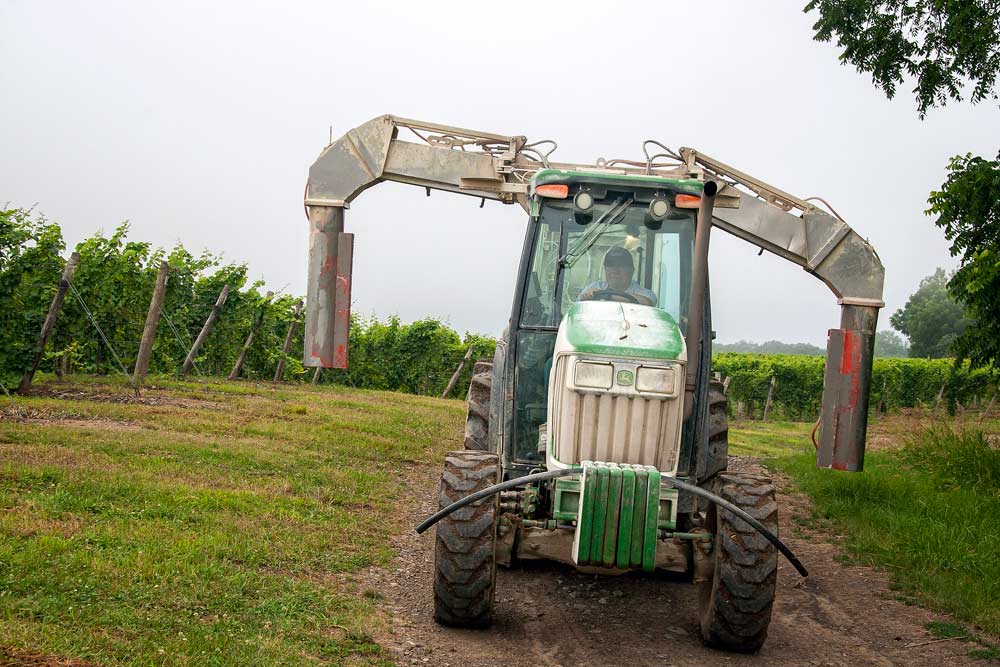
John Wagner prefers to use a Scott Henry training system for V. vinifera grapes because the two-tiered system allows for more canopy space and a more open fruiting zone. Here, the system is shown in July in a young Riesling block. (Kate Prengaman/Good Fruit Grower)
During the drought of 2016, growing grapes in New York was a lot like growing grapes in California.
It turned out to be a great vintage for Cabernet Sauvignon, but most seasons, growers who want to grow high quality wine grapes in the region have to figure out how to protect vines from winter injury, minimize disease and maximize flavor in a cool growing region with less sunshine and more humidity.
Fourth-generation Finger Lakes grape grower John Wagner has spent his career doing just that.
When his father opened a winery in 1976, the farm only grew French-American hybrid grapes, but today Wagner Vineyards has 225 acres of grapes, about half planted in vinifera.
“In the last 20 years, we have planted a lot of Riesling. It’s the variety of grape that year in and year out is producing pretty distinctive wines for the Finger Lakes.
In a (very rainy) year like this, we’re still producing wines with good character,” Wagner told Good Fruit Grower.
He’s one of the larger wine grape growers in the region and always one of the early adopters of new innovations and efficiencies, said Hans Walter-Peterson, the extension viticulturist for the Cornell Cooperative Extension Finger Lakes Grape Program.
“John wants to know what’s new, and he’s really good at thinking about how to integrate things into his operation,” Walter-Peterson said.
To coax the best character out of his vinifera, Wagner swears by a tiered trellis system that allows for both an open fruiting zone and more canopy, leaf removal, good drainage, hilling and a “spare parts” strategy to prevent losses to winter injury.

French-American hybrid grapes such as this Vignoles are grown without shoot positioning at Wagner Vineyards, which reduces labor costs. (Kate Prengaman/Good Fruit Grower)
That’s a lot more labor than goes into growing hardy hybrid grapes, which he grows on a high cordon system without shoot-positioning. But with prices in the region for vinifera grapes about twice that of hybrids, the extra management pays off.
Hilling up
In the Finger Lakes, European cultivars make up just 15 percent of the region’s 10,000 acres of grapes. But interest is growing, and new plantings in the area are likely to be Riesling or some of the new cold-hardy varieties from Minnesota, Walter-Peterson said.
The region’s namesake lakes dive deep enough to moderate local temperatures, making the slopes ideal for wine grapes. But even on the shores of Seneca Lake where Wagner grows, winter injury remains a very real risk, and that guides his management.
“The most severe temperature we’ve had since I’ve been alive was 1980, when it was 20 below on Christmas morning. They called it the Christmas Eve massacre. Any vinifera bud that was above the snow level was dead,” Wagner said. “Hilling up ensures that in a year like that, you don’t lose the vine. We miss a crop year, but we don’t lose the vines.”
Hilling up, the practice of covering the graft union with soil to insulate the vines, is common in the Finger Lakes and actually required as a condition of crop insurance, Walter-Peterson said.
Moving the dirt up each fall and pulling it down each spring without damaging the vines is tedious work most growers do by dragging a specialized plow behind a tractor along each side of the row.
To make the process far more efficient, Wagner, who studied engineering in college, built his own de-hiller in the frame of an over-the-row harvester that does both sides of the row at once.
After the plows in front push most of the dirt back into the furrows, sensor-driven hoes that can articulate around the vines follow to remove the thinner strip of dirt down the center of the row and expose the vines, Wagner explained.
That’s the sort of innovation that has enabled him to efficiently manage one of the larger vineyards in the region, Walter-Peterson said.
Warding off winter injury

To guard against losses to winter injury, grower John Wagner practices “spare parts viticulture” to maintain two trunks and a replacement shoot on all his V. vinifera vines at Wagner Vineyards in the Finger Lakes Region of New York. (Kate Prengaman/Good Fruit Grower)
Like many of his neighbors, Wagner also practices what he calls “spare parts viticulture.” Each vine grows with two trunks and a sucker so there are replacement options at the ready if winter injury occurs.
“You can see the stump from one we’ve taken off, this 7- or 8-year trunk, a 2- or 3-year trunk, and a renewal shoot from this year,” Wagner said, pointing to a 12-year-old Riesling block. “It’s a lot of work to ensure that you are going to have trunks and vines in the future. We could have just one trunk, but then there’s no second chapter.”
All those trunks reach up into a complex canopy structure that also takes more time to manage but gives the fruit more exposure.
While most growers in the region use VSP training, Wagner prefers the Scott Henry system that creates four cordons — two upper that grow like VSP and two lower that grow down — to better manage vigor and open up the fruiting zones in mature vines.

The slopes along Seneca Lake are desirable for grapes because the lake moderates winter temperatures, but farming sloping ground can require equipment modifications, such as this sprayer with arms that can be raised or lowered separately.
(Kate Prengaman/Good Fruit Grower)
“We’re a big proponent of taking that additional time to open up the canopy,” he said. “There’s more canopy area and less fruit shading so it’s the best of both worlds: You get more solar collectors to ripen the fruit in the open fruit zone.”
Leaf removal in the fruiting zone further opens the canopy.
Wagner uses a collared compressed air system that blows off leaves with pulses of air just after fruit set, because doing so later in the season risks both bruising and sunburn. In his premium blocks, he said he aims for 4 tons per acre; any less than that doesn’t improve fruit quality as some winemakers contend.
“Really, it’s balanced vine size. Two tons per acre and huge vigorous shoots, that’s not ideal. Ten tons per acre and a little tiny canopy is not ideal,” he said. “But in between, where you have a medium crop and a nice healthy canopy and plenty of surface area, is where we’ve made some (award-winning) Rieslings.”
Even with all that canopy management, some years the growing conditions challenge later ripening varieties, such as Cabernet Sauvignon and Merlot, and the fruit doesn’t develop enough character to make an estate wine, so they turn it into a value line red blend instead, Wagner said.
All told, he grows 20 varieties. The family winery takes about half of what’s grown in the vineyards, and the rest gets sold to about 30 different wineries in the growing Finger Lakes region, which is now home to over 200 wineries. •
– by Kate Prengaman






Leave A Comment